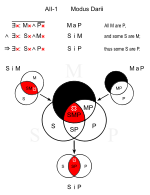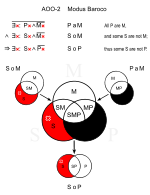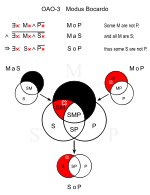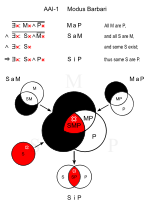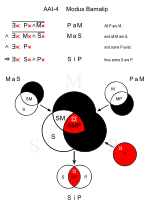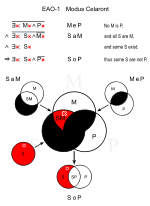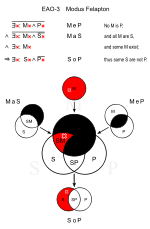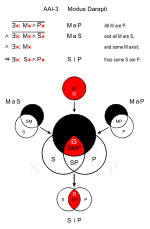- Syllogism
-
A syllogism (Greek: συλλογισμός – syllogismos – "conclusion," "inference") is a kind of logical argument in which one proposition (the conclusion) is inferred from two or more others (the premises) of a certain form. In antiquity, there were two rival theories of the syllogism: Aristotelian syllogistic and Stoic syllogistic.[1]
In the Prior Analytics, Aristotle defines the syllogism as "a discourse in which, certain things having been supposed, something different from the things supposed results of necessity because these things are so." (24b18–20)
Despite this very general definition, in the Prior Analytics, Aristotle limits himself to categorical syllogisms, which consist of three categorical propositions.[2] These included categorical modal syllogisms.[3] From the Middle Ages onwards, "categorical syllogism" and "syllogism" were mostly used interchangeably, and the present article is concerned with this traditional use of "syllogism" only. The syllogism was at the core of traditional deductive reasoning, where facts are determined by combining existing statements, in contrast to inductive reasoning where facts are determined by repeated observations. The syllogism was superseded by first-order predicate logic following the work of Gottlob Frege, in particular his Begriffsschrift (Concept Script) (1879).
Contents
Basic structure
A categorical syllogism consists of three parts: the major premise, the minor premise and the conclusion.
Each part is a categorical proposition, and each categorical proposition contains two categorical terms.[4] In Aristotle, each of the premises is in the form "All A are B," "Some A are B", "No A are B" or "Some A are not B", where "A" is one term and "B" is another. "All A are B," and "No A are B" are termed universal propositions; "Some A are B" and "Some A are not B" are termed particular propositions. More modern logicians allow some variation. Each of the premises has one term in common with the conclusion: in a major premise, this is the major term (i.e., the predicate of the conclusion); in a minor premise, it is the minor term (the subject) of the conclusion. For example:
- Major premise: All men are mortal.
- Minor premise: All Greeks are men.
- Conclusion: All Greeks are mortal.
Each of the three distinct terms represents a category. In the above example, "men," "mortal," and "Greeks." "Mortal" is the major term; "Greeks", the minor term. The premises also have one term in common with each other, which is known as the middle term; in this example, "man." Both of the premises are universal, as is the conclusion.
- Major premise: All mortals die.
- Minor premise: Some men are mortals.
- Conclusion: Some men die.
Here, the major term is "die", the minor term is "men," and the middle term is "mortals". The major premise is universal; the minor premise and the conclusion are particular.
A sorites is a form of argument in which a series of incomplete syllogisms is so arranged that the predicate of each premise forms the subject of the next until the subject of the first is joined with the predicate of the last in the conclusion. For example, if one argues that a given number of grains of sand does not make a heap and that an additional grain does not either, then to conclude that no additional amount of sand will make a heap is to construct a sorites argument.
Types of syllogism
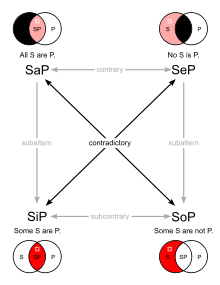 Relationships between the four types of propositions in the square of opposition
Relationships between the four types of propositions in the square of opposition
(Black areas are empty,
red areas are nonempty.)Although there are infinitely many possible syllogisms, there are only a finite number of logically distinct types. We shall classify and enumerate them below. Note that the syllogism above has the abstract form:
- Major premise: All M are P.
- Minor premise: All S are M.
- Conclusion: All S are P.
(Note: M – Middle, S – subject, P – predicate. See below for more detailed explanation.)
The premises and conclusion of a syllogism can be any of four types, which are labeled by letters[5] as follows. The meaning of the letters is given by the table:
code quantifier subject copula predicate type example a All S are P universal affirmatives All humans are mortal. e No S are P universal negatives No humans are perfect. i Some S are P particular affirmatives Some humans are healthy. o Some S are not P particular negatives Some humans are not clever. In Analytics, Aristotle mostly uses the letters A, B and C (actually, the Greek letters alpha, beta and gamma) as term place holders, rather than giving concrete examples, an innovation at the time. It is traditional to use is rather than are as the copula, hence All A is B rather than All As are Bs. It is traditional and convenient practice to use a, e, i, o as infix operators to enable the categorical statements to be written succinctly thus:
Form Shorthand All A is B AaB No A is B AeB Some A is B AiB Some A is not B AoB This particular syllogistic form is dubbed BARBARA (see below) and can be written neatly as BaC,AaB -> AaC.
The letter S is the subject of the conclusion, P is the predicate of the conclusion, and M is the middle term. The major premise links M with P and the minor premise links M with S. However, the middle term can be either the subject or the predicate of each premise where it appears. The differing positions of the major, minor, and middle terms gives rise to another classification of syllogisms known as the figure. Given that in each case the conclusion is S-P, the four figures are:
Figure 1 Figure 2 Figure 3 Figure 4 Major premise: M–P P–M M–P P–M Minor premise: S–M S–M M–S M–S Putting it all together, there are 256 possible types of syllogisms (or 512 if the order of the major and minor premises is changed, although this makes no difference logically). Each premise and the conclusion can be of type A, E, I or O, and the syllogism can be any of the four figures. A syllogism can be described briefly by giving the letters for the premises and conclusion followed by the number for the figure. For example, the syllogism BARBARA above is AAA-1, or "A-A-A in the first figure".
The vast majority of the 256 possible forms of syllogism are invalid (the conclusion does not follow logically from the premises). The table below shows the valid forms. Even some of these are sometimes considered to commit the existential fallacy, meaning they are invalid if they mention an empty category. These controversial patterns are marked in italics.
Figure 1 Figure 2 Figure 3 Figure 4 Barbara Cesare Datisi Calemes Celarent Camestres Disamis Dimatis Darii Festino Ferison Fresison Ferio Baroco Bocardo Calemos Barbari Cesaro Felapton Fesapo Celaront Camestros Darapti Bamalip The letters A, E, I, O have been used since the medieval Schools to form mnemonic names for the forms as follows: 'Barbara' stands for AAA, 'Celarent' for EAE, etc.
Next to each premise and conclusion is a shorthand description of the sentence. So in AAI-3, the premise "All squares are rectangles" becomes "MaP"; the symbols mean that the first term ("square") is the middle term, the second term ("rectangle") is the predicate of the conclusion, and the relationship between the two terms is labeled "a" (All M are P).
The following table shows all syllogisms that are essentially different. The similar syllogisms share actually the same premises, just written in a different way. For example "Some pets are kittens" (SiM in Darii) could also be written as "Some kittens are pets" (MiS is Datisi).
In the Venn diagrams the black areas tell, that there are no elements, and the red areas tell, that there is at least one element.
Examples
Barbara (AAA-1)
- All men are mortal. (MaP)
- All Greeks are men. (SaM)
- ∴ All Greeks are mortal. (SaP)
Celarent (EAE-1)
Similar: Cesare (EAE-2)
- No reptiles have fur. (MeP)
- All snakes are reptiles. (SaM)
- ∴ No snakes have fur. (SeP)
Calemes (AEE-4) Calemes is like Celarent with S and P exchanged.
Similar: Camestres (AEE-2)- All snakes are reptiles. (PaM)
- No reptiles have fur. (MeS)
- ∴ No fur bearing animal is a snake. (SeP)
Darii (AII-1)
Similar: Datisi (AII-3)
- All rabbits have fur. (MaP)
- Some pets are rabbits. (SiM)
- ∴ Some pets have fur. (SiP)
Dimatis (IAI-4) Dimatis is like Darii with S and P exchanged.
Similar: Disamis (IAI-3)- Some pets are rabbits. (PiM)
- All rabbits have fur. (MaS)
- ∴ Some fur bearing animals are pets. (SiP)
Ferio (EIO-1)
Similar: Festino (EIO-2), Ferison (EIO-3), Fresison (EIO-4)
- No homework is fun. (MeP)
- Some reading is homework. (SiM)
- ∴ Some reading is not fun. (SoP)
Baroco (AOO-2)
- All informative things are useful. (PaM)
- Some websites are not useful. (SoM)
- ∴ Some websites are not informative. (SoP)
Bocardo (OAO-3)
- Some cats have no tails. (MoP)
- All cats are mammals. (MaS)
- ∴ Some mammals have no tails. (SoP)
Barbari (AAI-1)
- All men are mortal. (MaP)
- All Greeks are men. (SaM)
- ∴ Some Greeks are mortal. (SiP)
Bamalip (AAI-4) Bamalip is like Barbari with S and P exchanged:
- All Greeks are men. (PaM)
- All men are mortal. (MaS)
- ∴ Some mortals are Greek. (SiP)
Celaront (EAO-1)
Similar: Cesaro (EAO-2)
- No reptiles have fur. (MeP)
- All snakes are reptiles. (SaM)
- ∴ Some snakes have no fur. (SoP)
Camestros (AEO-2)
Similar: Calemos (AEO-4)
- All horses have hooves. (PaM)
- No humans have hooves. (SeM)
- ∴ Some humans are not horses. (SoP)
Felapton (EAO-3)
Similar: Fesapo (EAO-4)
- No flowers are animals. (MeP)
- All flowers are plants. (MaS)
- ∴ Some plants are not animals. (SoP)
Darapti (AAI-3)
- All squares are rectangles. (MaP)
- All squares are rhombs. (MaS)
- ∴ Some rhombs are rectangles. (SiP)
Table of all syllogisms
This table shows all 24 valid syllogisms, represented by Venn diagrams.
(9 of them, on the right side of the table, require that one category must not be empty.)
Syllogisms of the same type are in the same row, and very similar syllogisms are in the same column.1 
Barbara
Celarent
Darii
Ferio
Barbari
Celaront2 
Cesare
Camestres
Festino
Baroco
Cesaro
Camestros3 
Datisi
Disamis
Ferison
Bocardo
Felapton
Darapti4 
Calemes
Dimatis
Fresison
Calemos
Fesapo
BamalipTerms in syllogism
We may, with Aristotle, distinguish singular terms such as Socrates and general terms such as Greeks. Aristotle further distinguished (a) terms that could be the subject of predication, and (b) terms that could be predicated of others by the use of the copula (is are). (Such a predication is known as a distributive as opposed to non-distributive as in Greeks are numerous. It is clear that Aristotle's syllogism works only for distributive predication for we cannot reason All Greeks are animals, animals are numerous, therefore All Greeks are numerous.) In Aristotle’s view singular terms were of type (a) and general terms of type (b). Thus Men can be predicated of Socrates but Socrates cannot be predicated of anything. Therefore to enable a term to be interchangeable — that is to be either in the subject or predicate position of a proposition in a syllogism — the terms must be general terms, or categorical terms as they came to be called. Consequently the propositions of a syllogism should be categorical propositions (both terms general) and syllogisms employing just categorical terms came to be called categorical syllogisms.
It is clear that nothing would prevent a singular term occurring in a syllogism — so long as it was always in the subject position — however such a syllogism, even if valid, would not be a categorical syllogism. An example of such would be Socrates is a man, All men are mortal, therefore Socrates is mortal. Intuitively this is as valid as All Greeks are men, all men are mortal therefore all Greeks are mortals. To argue that its validity can be explained by the theory of syllogism it would be necessary to show that Socrates is a man is the equivalent of a categorical proposition. It can be argued Socrates is a man is equivalent to All that are identical to Socrates are men, so our non-categorical syllogism can be justified by use of the equivalence above and then citing BARBARA.
Existential import
If a statement includes a term so that the statement is false if the term has no instances (is not instantiated) then the statement is said to entail existential import with respect to that term. In particular, a universal statement of the form All A is B has existential import with respect to A if All A is B is false if there are no As.
The following problems arise:
- (a) In natural language and normal use, which statements of the forms All A is B, No A is B, Some A is B and Some A is not B have existential import and with respect to which terms?
- (b) In the four forms of categorical statements used in syllogism, which statements of the form AaB, AeB, AiB and AoB have existential import and with respect to which terms?
- (c) What existential imports must the forms AaB, AeB, AiB and AoB have for the square of opposition be valid?
- (d) What existential imports must the forms AaB, AeB, AiB and AoB to preserve the validity of the traditionally valid forms of syllogisms?
- (e) Are the existential imports required to satisfy (d) above such that the normal uses in natural languages of the forms All A is B, No A is B, Some A is B and Some A is not B are intuitively and fairly reflected by the categorical statements of forms Ahab, Abe, Ail and Alb?
For example, if it is accepted that AiB is false if there are no As and AaB entails AiB, then AiB has existential import with respect to A, and so does AaB. Further, if it is accepted that AiB entails BiA, then AiB and AaB have existential import with respect to B as well. Similarly, if AoB is false if there are no As, and AeB entails AoB, and AeB entails BeA (which in turn entails BoA) then both AeB and AoB have existential import with respect to both A and B. It follows immediately that all universal categorical statements have existential import with respect to both terms. If AaB and AeB is a fair representation of the use of statements in normal natural language of All A is B and No A is B respectively, then the following example consequences arise:
- "All flying horses are mythological" is false if there are not flying horses.
- If "No men are fire-eating rabbits" is true, then "There are fire-eating rabbits" is false.
and so on.
If it is ruled that no universal statement has existential import then the square of opposition fails in several respects (e.g. AaB does not entail AiB) and a number of syllogisms are no longer valid (e.g. BaC,AaB->AiC).
These problems and paradoxes arise in both natural language statements and statements in syllogism form because of ambiguity, in particular ambiguity with respect to All. If "Fred claims all his books were Pulitzer Prize winners", is Fred claiming that he wrote any books? If not, then is what he claims true? Suppose Jane says none of her friends are poor; is that true if she has no friends? The first-order predicate calculus avoids the problems of such ambiguity by using formulae that carry no existential import with respect to universal statements; existential claims have to be explicitly stated. Thus natural language statements of the forms All A is B, No A is B, Some A is B and Some A is not B can be exactly represented in first order predicate calculus in which any existential import with respect to terms A and/or B is made explicitly or not made at all. Consequently the four forms AaB, AeB, AiB and AoB can be represented in first order predicate in every combination of existential import, so that it can establish which construal, if any, preserves the square of opposition and the validly of the traditionally valid syllogism. Strawson claims that such a construal is possible, but the results are such that, in his view, the answer to question (a) above is no.
Syllogism in the history of logic
Main article: History of LogicAristotelian syllogistic dominated Western philosophical thought from the 3rd Century to the 17th Century. At that time, Sir Francis Bacon rejected the idea of syllogism and deductive reasoning by asserting that it was fallible and illogical.[6] Bacon offered a more inductive approach to logic in which experiments were conducted and axioms were drawn from the observations discovered in them.
In the 19th Century, modifications to syllogism were incorporated to deal with disjunctive ("A or B") and conditional ("if A then B") statements. Kant famously claimed, in Logic (1800), that logic was the one completed science, and that Aristotelian logic more or less included everything about logic there was to know. Though it should be kept in mind that this work is not necessarily representative of Kant's mature philosophy, and that this philosophy is generally regarded as an innovation to logic itself. Though there were alternative systems of logic such as Avicennian logic or Indian logic elsewhere, Kant's opinion stood unchallenged in the West until 1879 when Frege published his Begriffsschrift (Concept Script). This introduced a calculus, a method of representing categorical statements — and statements that are not provided for in syllogism as well — by the use of quantifiers and variables.
This led to the rapid development of sentential logic and first-order predicate logic, subsuming syllogistic reasoning, which was, therefore, after 2000 years, suddenly considered obsolete by many. The Aristotelian system is explicated in modern fora of academia primarily in introductory material and historical study.
One notable exception to this modern relegation is the continued application of Aristotelian logic by officials of the Congregation for the Doctrine of the Faith, and the Apostolic Tribunal of the Roman Rota, which still requires that arguments crafted by Advocates be presented in syllogistic format.
Syllogistic Fallacies
See also: Syllogistic fallacyPeople often make mistakes when reasoning syllogistically.[7]
For instance, from the premises some A are B, some B are C, people tend to come to a definitive conclusion that therefore some A are C.[8] However, this does not follow according to the rules of classical logic. For instance, while some cats (A) are black (B), and some black things (B) are televisions (C), it does not follow from the parameters that some cats (A) are televisions (C). This is because first, the mood of the syllogism invoked is illicit (III), and second, the supposition of the middle term is variable between that of the middle term in the major premise, and that of the middle term in the minor premise (not all "some" cats are by necessity of logic the same "some black things").
Determining the validity of a syllogism involves determining the distribution of each term in each statement, meaning whether all members of that term are accounted for.
In simple syllogistic patterns, the fallacies of invalid patterns are:
- Undistributed middle: Neither of the premises accounts for all members of the middle term, which consequently fails to link the major and minor term.
- Illicit treatment of the major term: The conclusion implicates all members of the major term (P — meaning the proposition is negative); however, the major premise does not account for them all (i.e., P is either an affirmative predicate or a particular subject there).
- Illicit treatment of the minor term: Same as above, but for the minor term (S — meaning the proposition is universal) and minor premise (where S is either a particular subject or an affirmative predicate).
- Exclusive premises: Both premises are negative, meaning no link is established between the major and minor terms.
- Affirmative conclusion from a negative premise: If either premise is negative, the conclusion must also be.
- Negative conclusion from affirmative premises: If both premises are affirmative, the conclusion must also be.
- Existential fallacy: This is a more controversial one. If both premises are universal, i.e. "All" or "No" statements, one school of thought says they do not imply the existence of any members of the terms. In this case, the conclusion cannot be existential; i.e. beginning with "Some". Another school of thought says that affirmative statements (universal or particular) do imply the subject's existence, but negatives do not. A third school of thought says that the any type of proposition may or may not involve the subject's existence, and although this may condition the conclusion it does not affect the form of the syllogism.
See also
- Enthymeme
- Other types of syllogism:
- Syllogistic fallacy
- The False Subtlety of the Four Syllogistic Figures
- Venn diagram
Notes
- ^ Michael Frede, "Stoic vs. Peripatetic Syllogistic", Archive for the History of Philosophy 56, 1975, 99-124.
- ^ [1] Stanford Encyclopedia of Philosophy: Ancient Logic Aristotle Non-Modal Syllogistic
- ^ [2] Stanford Encyclopedia of Philosophy: Ancient Logic Aristotle Modal Logic
- ^ "Philosophical Dictionary: Caird-Catharsis". Philosophypages.com. 2002-08-08. http://www.philosophypages.com/dy/c.htm#capro. Retrieved 2009-12-14.
- ^ According to Copi, p. 127: 'The letter names are presumed to come from the Latin words "AffIrmo" and "nEgO," which mean "I affirm" and "I deny," respectively; the first capitalized letter of each word is for universal, the second for particular'
- ^ Bacon, Francis. The Great Instauration, 1620
- ^ See, e.g., Evans, J. St. B. T (1989). Bias in human reasoning. London: LEA.
- ^ See the meta-analysis by Chater, N. & Oaksford, M. (1999). The Probability Heuristics Model of Syllogistic Reasoning. Cognitive Psychology, 38, 191–258.
References
- Aristotle, Prior Analytics. transl. Robin Smith (Hackett, 1989) ISBN 0-87220-064-7
- Blackburn, Simon, 1996. "Syllogism" in the Oxford Dictionary of Philosophy. Oxford University Press. ISBN 0-19-283134-8.
- Broadie, Alexander, 1993. Introduction to Medieval Logic. Oxford University Press. ISBN 0-19-824026-0.
- Irving Copi, 1969. Introduction to Logic, 3rd ed. Macmillan Company.
- John Corcoran (logician), 1972. Completeness of an ancient logic Journal of Symbolic Logic 37: 696–702.
- John Corcoran (logician), 1994. The founding of logic. Modern interpretations of Aristotle's logic Ancient Philosophy 14: 9–24.
- Hamblin, Charles L., 1970. Fallacies, Methuen : London, ISBN 0-416-70070-5. Cf. on validity of syllogisms: "A simple set of rules of validity was finally produced in the later Middle Ages, based on the concept of Distribution.“
- Jan Łukasiewicz, 1987 (1957). Aristotle's Syllogistic from the Standpoint of Modern Formal Logic. New York: Garland Publishers. ISBN 0824069242. OCLC 15015545.
- Smiley Timothy, 1973. "What is a syllogism?," Journal of Philosophical Logic 2: 136–154.
- Smith Robin, 1986. "Immediate propositions and Aristotle's proof theory," Ancient Philosophy 6: 47–68.
External links
- Aristotle's Logic entry by Robin Smith in the Stanford Encyclopedia of Philosophy
- The Traditional Square of Opposition entry by Terence Parsons in the Stanford Encyclopedia of Philosophy
- Medieval Theories of the Syllogism entry by Henrik Lagerlund in the Stanford Encyclopedia of Philosophy
- Aristotle's Prior Analytics: the Theory of Categorical Syllogism an annotated bibliography on Aristotle's syllogistic
- Abbreviatio Montana article by Prof. R. J. Kilcullen of Macquarie University on the medieval classification of syllogisms.
- The Figures of the Syllogism is a brief table listing the forms of the syllogism.
- Interactive Syllogistic Machine A web based syllogistic machine for exploring fallacies, figures, and modes of syllogisms.
- www.fibonicci.co.uk/syllogisms some fun syllogism tests/quizzes
- Syllogistic Reasoning in Buddhism – Example & Worksheet
Categories:- Traditional logic
- Greek loanwords
- Arguments
Wikimedia Foundation. 2010.




